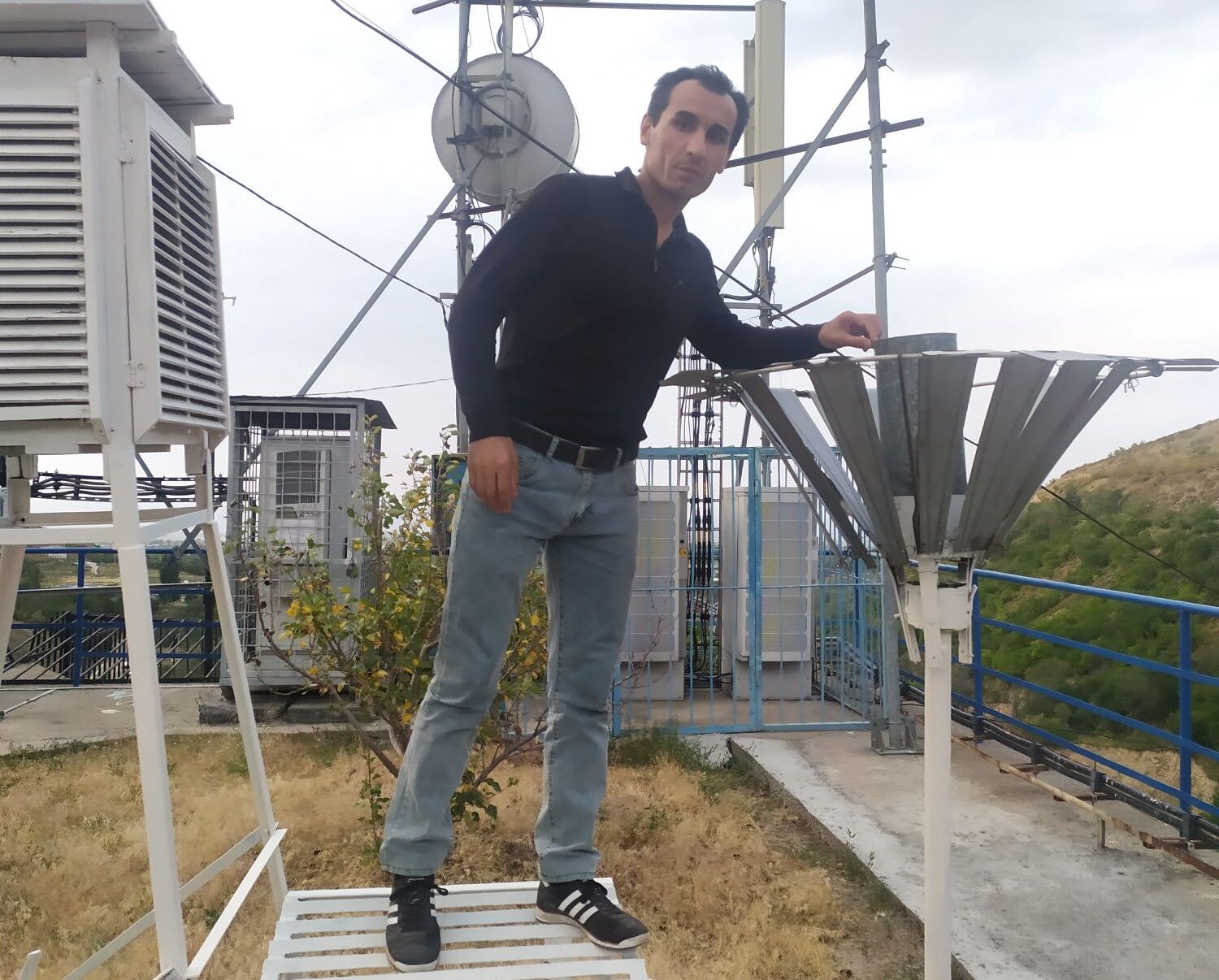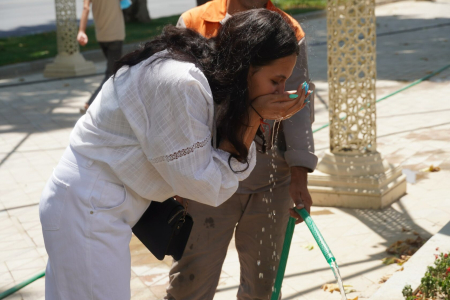This raises an important question: What might happen in the next 50 years if temperatures continue to rise at this rate? We sought to answer this by using artificial intelligence (AI) tools, which, after analyzing the data, provided a forecast of changes in average annual temperatures in four Tajik cities—Bokhtar, Dushanbe, Khorog, and Khujand—over the next half-century.
According to the AI’s projections, the average annual temperature in Bokhtar is expected to rise from 18.3°C to 19.8°C by 2070. In Dushanbe, the AI predicts an increase to 19.0°C. In Khorog, the average annual temperature may climb to 12.2°C, while in Khujand, it is forecasted to reach 18.0°C by 2070.
Meanwhile, climatologists have confirmed that July 2023 was the hottest month on record. According to Carsten Hausstein, a climatologist at Leipzig University, the global average temperature in July last year exceeded the pre-industrial level (average temperature in 1850-1900) by 1.5°C.
“It is expected that temperatures in 2024 could be even higher,” said Samantha Burgess, deputy director of the EU’s Copernicus Climate Change Service. Many causes and factors influence climate change, noted Nomvar Kurbon, a meteorologist and deputy director for science and education at the Institute of Water Problems, Hydropower, and Ecology of the National Academy of Sciences of Tajikistan.
“The most widespread and popular hypothesis regarding the causes of contemporary global climate change is anthropogenic impact. The rapid rate of climate change is linked to the intensification of human activities that contribute to the increase of greenhouse gases in the atmosphere,” said the scientist.
According to Nomvar Kurbon, in recent years—especially in the summer of 2023—the sudden rise in air temperature and the surpassing of all expected rates and projections of temperature increase has caused concern even among those far removed from science. According to the World Meteorological Organization (WMO), while 2012-2021 was the warmest decade since measurements began in 1850, the years 2016, 2020, and 2023 were the hottest on record.
Nomvar Qurbon says the UN Intergovernmental Panel on Climate Change (IPCC) estimates that increased greenhouse gas emissions will result in an average temperature increase of 1.4-5.5°C by the end of the 21st century compared to 1990.
According to the US Global Change Research Program (USGCRP) Climate Science Report, the global mean annual surface air temperature increased by approximately 1.0°C over 115 years (1901-2016). The World Meteorological Organization (WMO) has noted that the 20th century was the warmest in the last millennium. The USGCRP Climate Science Report anticipates that this trend will continue on a larger scale and over a more extended period.
The scientist says that while a few decades ago, there was a dramatic change in climate in one corner of the globe or another, in recent years, climate change has spread from mountain peaks to the ocean floor. Numerous droughts, floods, and heat waves have occurred, and Antarctic sea ice shrinkage has reached record levels.

How has the temperature increase manifested itself in Central Asia?
According to long-term instrumental observations of meteorological parameters throughout Central Asia, the region’s primary cause of climate change is a significant increase in surface air temperature.
“A sectoral review by the Eurasian Development Bank (EDB) back in 2009 indicated an increase in average annual air temperature across the Central Asian countries every ten years,” says Nomvar Qurbon.
For example, from 1950 to 2005, the average annual temperature in Uzbekistan increased by 0.29°C per decade. From 1936 to 2005, the yearly average temperature in Kazakhstan rose by 0.26°C per decade. In Turkmenistan, between 1961 and 1995, the average annual temperature increased by 0.18°C each decade. From 1883 to 2005, the yearly average temperature in Kyrgyzstan increased by 0.08°C per decade. From 1940 to 2005, Tajikistan’s average annual temperature rose by 0.10°C every ten years.
“The data provided by the EBD indicate that the temperature increase in Central Asia has been uneven. The highest rates of increase in average annual temperature were observed in the plains, while in mountainous areas, the rate of warming was weaker, and in some cases, even some cooling was observed. For example, in Kyrgyzstan, where the entire territory is mountainous, the average rate of warming was minimal compared to the rest of Central Asia,” the source said.
Nomvar Kurbon, citing EBD data, noted that most of the Central Asian region experienced the highest rates of temperature increase during winter.
For example, in Kazakhstan, the average air temperature increased by 0.44°C per decade in winter and by 0.14°C per decade in summer. In Kyrgyzstan, winter temperatures increase by 0.03°C every ten years. In Tajikistan, winter temperatures rose by 1.3-3.0°C from 1940 to 2005. In Turkmenistan, the pattern is reversed, with the air temperature increasing by 0.1°C per decade in winter and by 0.2°C in other seasons.
In Tajikistan’s high mountain belt (above 2500 m), the temperature trend showed positive values only in April, November, and December. A temperature decrease was also observed in some lowland areas. For example, in the basin of Lake Bulunkul, from 1940 to 2005, the mean annual temperature decreased by 1.1°C, which may be related to the unique climate characteristics of the Eastern Pamirs.
A Country with Four Climate Zones
Nomvar Qurbon noted that, unlike other Central Asian countries, Tajikistan has a great diversity of climatic conditions due to its altitudinal belts and geographical isolation, making it particularly interesting for studying and modeling climate change.
“Tajikistan’s climatic features are shaped by its location in the center of the Eurasian continent, far from seas and oceans, in the highlands of Central Asia. The territory of Tajikistan is always under the influence of two powerful and active centers of atmospheric movement, which determine the climate not only in the Central Asian region but also across much of Eurasia,” explained the specialist.
Nomvar Qurbon identified four climatic zones in Tajikistan: the desert highland climate region characteristic of the Eastern Pamir, the mountainous climate region typical of Kuhistan and the Western Pamir, the steppe climate region of the foothills, and the desert climate region.
“Therefore, Tajikistan can be considered a kind of model of the planet, as nearly all climatic zones are represented within its small territory, with a temperature range from +50°C to -60°C. Tajikistan’s climate is arid, characterized by an abundance of heat and significant fluctuations in intra-annual temperature: the absolute minimum is -63°C (Bulunkul), and the absolute maximum is +47°C (Shakhritus),” says the climatologist.
How has the temperature changed in Tajikistan?
According to meteorologists’ observations, from 1940 to 2017, the average annual temperature in Tajikistan varied depending on altitude, ranging from 17°C and higher in the south to -6°C and lower in the Pamirs. A relatively high-temperature increase was recorded in the valleys and plains (Dangara—1.2°C, Dushanbe—1.0°C), while in mountainous areas, the increase ranged from 0.3°C to 0.5°C. In the highland zones, the temperature increase was between 0.2°C and 0.4°C.
“Additionally, the number of days with temperatures of +40°C and higher has been increasing yearly in Tajikistan. In mountainous areas, temperatures rise by +0.3 to +0.5°C, and in the highlands by +0.2 to +0.4°C. The recent warming trend observed from 2001 to 2010 indicates that the average temperature for each decade is +0.8°C higher than that in regions located at 1000-2500 meters.
In the highlands, there has been an increase of +0.2°C above the norm, with winter air temperatures averaging between +0.1 and +1.1°C and spring temperatures ranging from +0.1 to +1.3°C. Overall, during 77 years of observations in Dushanbe, Khujand, and Bokhtar, 748 instances of high temperatures in the range of +37.0 to +37.9°C, and 501 instances with temperatures between +38.0 and +38.9°C were recorded. In the Darvaz, Shahrituz, and Farkhor districts, particularly hot years included 1944, 1947, 1977, 1984, 1994, 1997, 2006, and 2008. Specifically, the days with high temperatures of +37.0 to +37.9°C reached 1,249 in Farkhor, 1,173 in Bokhtar, 1,093 in Shahrituz, and 519 in Darvaz. ‘By 2030, the specialist emphasized that the average annual temperature in most regions of Tajikistan is expected to increase by +0.2 to +0.4°C.”
Forecast for the Coming Years
Climate change experts agree that in the next 100 years, the average temperature compared to the 1961-1990 average in the Central Asian region tends to increase from 1.02°C to 4.7°C in different years, Nomvar Kurbon said.
“According to the Regional Ecological Center of Central Asia (Almaty), in all regions of Kazakhstan in 2030, the average annual temperature will increase by 1.4°C, by 2.7°C in 2050, and by 4.6°C by 2085. Average yearly precipitation during this period in Kazakhstan will increase by 2 to 5%. In Kyrgyzstan, the average temperature and the average annual rainfall will fluctuate. For example, in 2050, the temperature will increase by 6.1°C, and the average annual precipitation will decrease by 2%. In Uzbekistan, the average yearly temperature also fluctuates. By 2030, it will increase by 1.2°C. The average yearly temperature in Turkmenistan will increase by five °C by 2085.
In all regions of the Republic of Tajikistan, the mean annual temperature by 2030 is expected to increase by 0.2-0.4°C compared to 1961-1990 levels and by five °C by 2085. This projection aligns with the trend observed over the last 15-20 years. According to these estimates, the mean annual temperature by 2050 will increase from -0.6°C to +1.1°C in the Panj River basin, from +3.5°C to 5.0°C in the Vakhsh River basin, and from -2.6°C to -0.9°C in the Pamir ice regions. During this period, average annual precipitation is expected to decrease by 5%, with relatively dry winters and wetter summers.
“In the Central Asian region, the average annual temperature is expected to increase by 1.02°C by 2030, 3.1°C by 2050, and 4.7°C by 2085. During this period, average annual precipitation in the Central Asian region is projected to increase by 2% by 2030 and then decrease by the same amount by 2085,” the scientist said.
Nomvar Qurbon noted that studies on climate change in Tajikistan over various years indicate that climate change mirrors global trends, though it exhibits its regional peculiarities.
The scientist is confident that the analysis of temperature changes and their projected ranges confirms that global warming will continue to impact Tajikistan’s climate significantly.
“Tajikistan is facing serious challenges related to climate change and rising temperatures. To mitigate the negative impacts, urgent measures are needed to adapt to these changes, including the development of sustainable land use practices, effective water management, improved land use systems, and the conservation of biodiversity, flora, and fauna in the country and the region as a whole,” concluded Nomvar Qurbon.
https://cabar.asia/en/climate-change-and-temperature-increase-future-forecast
Last modified on Wednesday, 04 September 2024 English
English
 Тоҷикӣ
Тоҷикӣ  Русский
Русский 
